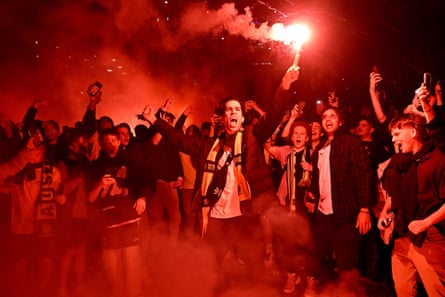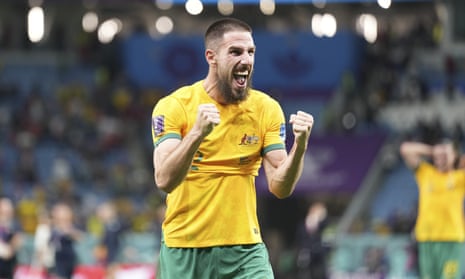Stunned, shocked, amazed, astounded. Throw in any other adjectives you like. Australia’s qualification for the round of 16 at the World Cup, after back-to-back wins over Tunisia and Denmark, has captured the imagination of a nation and surprised a planet.
Not since that thrilling journey in Germany 16 years ago, when Guus Hiddink and the so-called “Golden Generation” pushed Italy all the way in Kaiserslautern, has football been more relevant Down Under. It’s fitting that this current group is led by Hiddink’s assistant during that World Cup campaign, Graham Arnold.
It’s also fitting that this current squad of Socceroos were just kids when history was made in 2006, and were notably inspired to follow in their famous forebears’ footsteps nearly two decades later. It should also be noted that it has happened at the 2022 tournament, one that Australia bid for but lost out to hosts Qatar, a decision that caused massive ructions at home and has continued to make waves around the world.
Harking back to 2006 is relevant as that was a time when football, or soccer as it was more commonly called in that era, reinvented itself in Australia. The A-League had been launched, the Socceroos had qualified for a World Cup for the first time in 32 years, Australia had moved out of the Oceania Football Confederation and into Asia, and Soccer Australia had been dumped, replaced by a new governing body in Football Federation Australia.
It was a time of optimism, joy and hope. The sick man of Australian sport had finally woken up. The other codes were put on notice.
Quick GuideQatar: beyond the football
Show

It was a World Cup like no other. For the last 12 years the Guardian has been reporting on the issues surrounding Qatar 2022, from corruption and human rights abuses to the treatment of migrant workers and discriminatory laws. The best of our journalism is gathered on our dedicated Qatar: Beyond the Football home page for those who want to go deeper into the issues beyond the pitch.
Guardian reporting goes far beyond what happens on the pitch. Support our investigative journalism today.
But the next 16 years have continued the boom and bust cycle that football has long been known for. The Socceroos disappointed at the 2007 Asian Cup, managed qualification for the 2010, 2014 and 2018 World Cups but registered just one victory from nine attempts. The A-League eventually expanded, with new clubs around the country slowly introduced.
Media coverage grew and News Corp invested in the sport. Participation continued to flourish and football entered the mainstream. It was not without road bumps – the controversial 2010 World Cup bid, stoushes between FFA and A-League active support, and Frank Lowy’s eventual exit in 2015.
It was not without genuine high points either – Ange Postecoglou’s Socceroos reign was a breath of fresh air that culminated in winning the 2015 Asian Cup on home soil. The Australia Cup was introduced and the A-League peaked in 2014 when nearly two million fans attended matches, and the competition welcomed marquee players in Alessandro Del Piero, Emile Heskey and Shinji Ono.

However, for the past eight years the A-League has been in slow decline, shedding TV viewers, supporters, big-name sponsors and media interest. SBS has largely walked away from football (although they have rights to the current tournament), News Corp pulled its investment and Covid-19 especially hit the competition hard. Political infighting and tensions between “old soccer” and “new football” spilled over, Postecoglou departed from the Socceroos in 2017 to head overseas and less than a year later Lowy’s son Steven, his controversial successor, left as chairman of FFA.
The highs of Germany in 2006, of huge TV audiences, 60,000 Sydney and 50,000-Melbourne derby crowds and front page newspaper coverage seemed long gone. Pessimism replaced optimism, a feeling known all too well by Australian football’s true believers.
But this World Cup has been a ray of light of what still can be. The Socceroos’ achievements in the Middle East have been backed by generous ratings, raucous support in pubs and live sites, and international acclaim. More than anything, it’s shown that the country still cares deeply for its national team and for the game.
“I truly believe that the Socceroos are the team that unites the country,” Arnold said after the 1-0 win over Denmark. “If the cricket team get to the final of the World Cup you don’t get scenes like tonight. You don’t see the squares like they are tonight, and not with the rugby union or rugby league either.”
Arnold is not wrong. Success is largely expected for the Kangaroos, Wallabies and in cricket, but football is a different beast. The Socceroos better represent the multicultural face of the nation, and the persona of Australia punching above its weight on the world stage. The world cares about football, and success in the round ball game can give the country more global relevance than any other sport.
The question now is how Australian football continues this moment, this feel-good factor and connects it to the A-Leagues and the domestic game. We have been here before and progress has largely been squandered. These seedlings cannot be left to wither once more.
There are some signs of hope. FFA has been canned, replaced by Football Australia and repairing old divisions has been a priority. A national second division will be born in 2023, and the Women’s World Cup will be hosted by Australia and New Zealand. The worth and value of the A-League has been reinforced by the Socceroos’ fantastic feats in Qatar.
Football has become too big to ignore in the big brown land, but it cannot be allowed to eat its own and self-harm as it has in the past. Regardless of how the Socceroos fare against Lionel Messi and La Albiceleste, Australia appears to have fallen in love with football and the Socceroos once more. But for how long?
